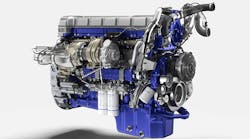According to Volvo Trucks North America (VTNA), its next generation engine with turbo compound technology provides up to an additional 3% improvement in fuel efficiency over the current 13-liter Turbo Compound engine, the D13TC. This new engine delivers up to 11% fuel savings overall compared to model-year 2015 trucks.
“We developed our first generation of the Turbo Compound engine in 2017, and since then almost 300 million miles have been logged, validating the up to 8% fuel-savings benefits,” said John Moore, product marketing manager at VTNA. “This new D13TC builds upon this game-changing engine technology, further increasing fuel efficiency by up to 3% over the current D13TC engine, saving approximately $1,200 per year per truck, based on the average fuel price and 125,000 miles per year.”
Volvo Trucks’ new D13TC engine offers:
- Three individual drive modes: extra efficiency, economy, and performance, which allows the driver to better optimize fuel efficiency for the vehicle with desired performance, depending on application, topography and driving conditions.
- Dynamic torque that automatically sets a torque level dependent upon the weight of the truck, the grade and the road conditions at any given time while also featuring an automatic 12th gear lockout on heavy loads with adaptive gearing engine ratings. A kick-down switch along with performance drive mode allows access to full torque for customers requiring it on demand.
- An additional 405 horsepower rating.
- A wider RPM efficiency band, which enables top fuel efficiency for longer periods of time.
- The next evolution of Volvo Trucks’ patented wave piston design, increasing the compression ratio from 17:1 to 18:1 while maintaining up to a 90% reduction of soot in the cylinder, further improving fuel efficiency in the engine.
These updates enable further-increased fuel efficiency over a wider range of loads, vehicle speeds and engine RPMs. This offers a broader use of applications compared to the first generation of the D13TC engine, which was designed specifically for over-the-road, long-haul applications for trucks loaded at 80,000 pounds, providing an even more consistent improvement in fuel efficiency across different applications, enabling customers to cut costs on a wider range of operations.



